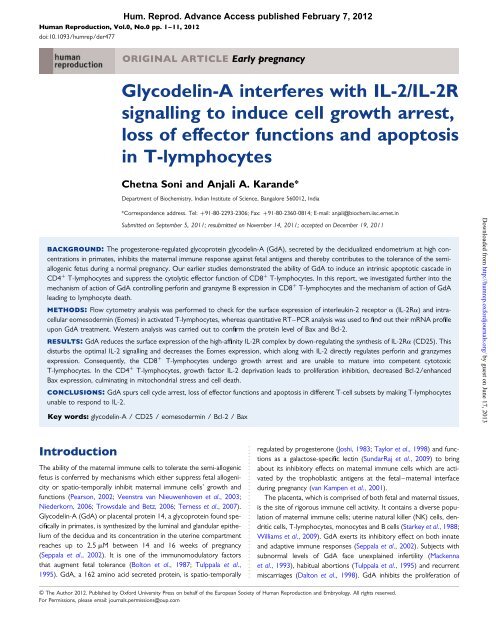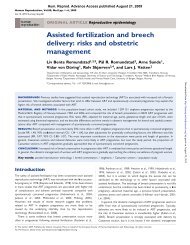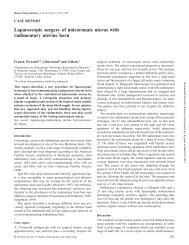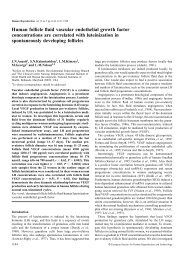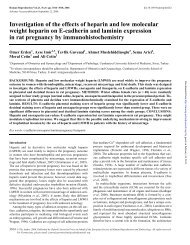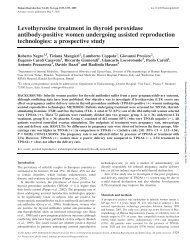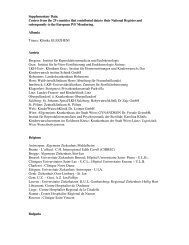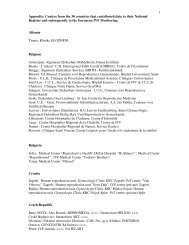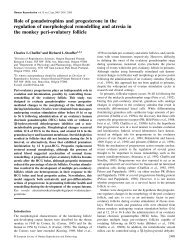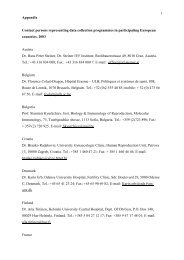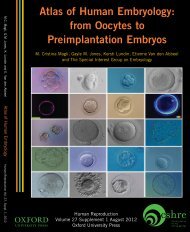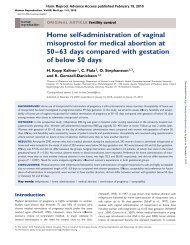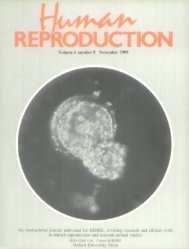Glycodelin-A interferes with IL-2/IL-2R signalling to induce cell ...
Glycodelin-A interferes with IL-2/IL-2R signalling to induce cell ...
Glycodelin-A interferes with IL-2/IL-2R signalling to induce cell ...
Create successful ePaper yourself
Turn your PDF publications into a flip-book with our unique Google optimized e-Paper software.
Human Reproduction, Vol.0, No.0 pp. 1–11, 2012<br />
doi:10.1093/humrep/der477<br />
ORIGINAL ARTICLE Early pregnancy<br />
<strong>Glycodelin</strong>-A <strong>interferes</strong> <strong>with</strong> <strong>IL</strong>-2/<strong>IL</strong>-<strong>2R</strong><br />
<strong>signalling</strong> <strong>to</strong> <strong>induce</strong> <strong>cell</strong> growth arrest,<br />
loss of effec<strong>to</strong>r functions and apop<strong>to</strong>sis<br />
in T-lymphocytes<br />
Chetna Soni and Anjali A. Karande*<br />
Department of Biochemistry, Indian Institute of Science, Bangalore 560012, India<br />
*Correspondence address. Tel: +91-80-2293-2306; Fax: +91-80-2360-0814; E-mail: anjali@biochem.iisc.ernet.in<br />
Submitted on September 5, 2011; resubmitted on November 14, 2011; accepted on December 19, 2011<br />
background: The progesterone-regulated glycoprotein glycodelin-A (GdA), secreted by the decidualized endometrium at high concentrations<br />
in primates, inhibits the maternal immune response against fetal antigens and thereby contributes <strong>to</strong> the <strong>to</strong>lerance of the semiallogenic<br />
fetus during a normal pregnancy. Our earlier studies demonstrated the ability of GdA <strong>to</strong> <strong>induce</strong> an intrinsic apop<strong>to</strong>tic cascade in<br />
CD4 + T-lymphocytes and suppress the cy<strong>to</strong>lytic effec<strong>to</strong>r function of CD8 + T-lymphocytes. In this report, we investigated further in<strong>to</strong> the<br />
mechanism of action of GdA controlling perforin and granzyme B expression in CD8 + T-lymphocytes and the mechanism of action of GdA<br />
leading <strong>to</strong> lymphocyte death.<br />
methods: Flow cy<strong>to</strong>metry analysis was performed <strong>to</strong> check for the surface expression of interleukin-2 recep<strong>to</strong>r a (<strong>IL</strong>-<strong>2R</strong>a) and intra<strong>cell</strong>ular<br />
eomesodermin (Eomes) in activated T-lymphocytes, whereas quantitative RT–PCR analysis was used <strong>to</strong> find out their mRNA profile<br />
upon GdA treatment. Western analysis was carried out <strong>to</strong> confirm the protein level of Bax and Bcl-2.<br />
results: GdA reduces the surface expression of the high-affinity <strong>IL</strong>-<strong>2R</strong> complex by down-regulating the synthesis of <strong>IL</strong>-<strong>2R</strong>a (CD25). This<br />
disturbs the optimal <strong>IL</strong>-2 <strong>signalling</strong> and decreases the Eomes expression, which along <strong>with</strong> <strong>IL</strong>-2 directly regulates perforin and granzymes<br />
expression. Consequently, the CD8 + T-lymphocytes undergo growth arrest and are unable <strong>to</strong> mature in<strong>to</strong> competent cy<strong>to</strong><strong>to</strong>xic<br />
T-lymphocytes. In the CD4 + T-lymphocytes, growth fac<strong>to</strong>r <strong>IL</strong>-2 deprivation leads <strong>to</strong> proliferation inhibition, decreased Bcl-2/enhanced<br />
Bax expression, culminating in mi<strong>to</strong>chondrial stress and <strong>cell</strong> death.<br />
conclusions: GdA spurs <strong>cell</strong> cycle arrest, loss of effec<strong>to</strong>r functions and apop<strong>to</strong>sis in different T-<strong>cell</strong> subsets by making T-lymphocytes<br />
unable <strong>to</strong> respond <strong>to</strong> <strong>IL</strong>-2.<br />
Key words: glycodelin-A / CD25 / eomesodermin / Bcl-2 / Bax<br />
Introduction<br />
Hum. Reprod. Advance Access published February 7, 2012<br />
The ability of the maternal immune <strong>cell</strong>s <strong>to</strong> <strong>to</strong>lerate the semi-allogenic<br />
fetus is conferred by mechanisms which either suppress fetal allogenicity<br />
or spatio-temporally inhibit maternal immune <strong>cell</strong>s’ growth and<br />
functions (Pearson, 2002; Veenstra van Nieuwenhoven et al., 2003;<br />
Niederkorn, 2006; Trowsdale and Betz, 2006; Terness et al., 2007).<br />
<strong>Glycodelin</strong>-A (GdA) or placental protein 14, a glycoprotein found specifically<br />
in primates, is synthesized by the luminal and glandular epithelium<br />
of the decidua and its concentration in the uterine compartment<br />
reaches up <strong>to</strong> 2.5 mM between 14 and 16 weeks of pregnancy<br />
(Seppala et al., 2002). It is one of the immunomodula<strong>to</strong>ry fac<strong>to</strong>rs<br />
that augment fetal <strong>to</strong>lerance (Bol<strong>to</strong>n et al., 1987; Tulppala et al.,<br />
1995). GdA, a 162 amino acid secreted protein, is spatio-temporally<br />
regulated by progesterone (Joshi, 1983; Taylor et al., 1998) and functions<br />
as a galac<strong>to</strong>se-specific lectin (SundarRaj et al., 2009) <strong>to</strong> bring<br />
about its inhibi<strong>to</strong>ry effects on maternal immune <strong>cell</strong>s which are activated<br />
by the trophoblastic antigens at the fetal–maternal interface<br />
during pregnancy (van Kampen et al., 2001).<br />
The placenta, which is comprised of both fetal and maternal tissues,<br />
is the site of rigorous immune <strong>cell</strong> activity. It contains a diverse population<br />
of maternal immune <strong>cell</strong>s; uterine natural killer (NK) <strong>cell</strong>s, dendritic<br />
<strong>cell</strong>s, T-lymphocytes, monocytes and B <strong>cell</strong>s (Starkey et al., 1988;<br />
Williams et al., 2009). GdA exerts its inhibi<strong>to</strong>ry effect on both innate<br />
and adaptive immune responses (Seppala et al., 2002). Subjects <strong>with</strong><br />
subnormal levels of GdA face unexplained infertility (Mackenna<br />
et al., 1993), habitual abortions (Tulppala et al., 1995) and recurrent<br />
miscarriages (Dal<strong>to</strong>n et al., 1998). GdA inhibits the proliferation of<br />
& The Author 2012. Published by Oxford University Press on behalf of the European Society of Human Reproduction and Embryology. All rights reserved.<br />
For Permissions, please email: journals.permissions@oup.com<br />
Downloaded from<br />
http://humrep.oxfordjournals.org/ by guest on June 17, 2013
2 Soni and Karande<br />
B <strong>cell</strong>s, along <strong>with</strong> reduced immunoglobulin M (IgM) secretion and<br />
major his<strong>to</strong>compatibility complex class II surface expression upon activation<br />
(Yaniv et al., 2003; Alok and Karande, 2009). Experiments<br />
carried out on peripheral NK <strong>cell</strong>s and decidual large granular lymphocytes<br />
confirm the ability of GdA <strong>to</strong> inhibit their cy<strong>to</strong>lytic activity<br />
(Okamo<strong>to</strong> et al., 1991) and <strong>to</strong> enhance interleukin-6 (<strong>IL</strong>-6), <strong>IL</strong>-13<br />
and granulocyte-macrophage colony-stimulating fac<strong>to</strong>r production<br />
from them, signifying its role in trophoblast invasion (Lee et al.,<br />
2010). Survival and proliferation of monocytes are inhibited (Tee<br />
et al., 2008; Alok et al., 2009) and dendritic <strong>cell</strong>s derived from monocytes<br />
acquire a <strong>to</strong>lerogenic phenotype on GdA treatment (Scholz<br />
et al., 2008).<br />
The most extensively studied effect of GdA is that on the<br />
T-lymphocytes. GdA inhibits the proliferation of mi<strong>to</strong>gen stimulated<br />
T-<strong>cell</strong>s (Bol<strong>to</strong>n et al., 1987; Pockley and Bol<strong>to</strong>n, 1989; Rachmilewitz<br />
et al., 1999; Mukhopadhyay et al., 2001). Additionally, it <strong>induce</strong>s apop<strong>to</strong>sis<br />
in activated T-lymphocytes (Mukhopadhyay et al., 2001) and<br />
the protein backbone is necessary and sufficient for this activity<br />
(Jayachandran et al., 2004). Importantly, the N-linked glycosylation<br />
on GdA modulates accessibility of the active site on the protein<br />
(Mukhopadhyay et al., 2004; Jayachandran et al., 2006; Poornima<br />
and Karande, 2007). GdA also shifts the Th1–Th2 cy<strong>to</strong>kine balance<br />
<strong>to</strong>wards Th2 cy<strong>to</strong>kines (Mishan-Eisenberg et al., 2004) by selectively<br />
triggering apop<strong>to</strong>sis in Th1 <strong>cell</strong>s (Lee et al., 2011). Interestingly, like<br />
the Th2 <strong>cell</strong>s, B <strong>cell</strong>s (Alok and Karande, 2009) as well as CD8 + Tlymphocytes<br />
are resistant <strong>to</strong> GdA-<strong>induce</strong>d apop<strong>to</strong>sis (Soni and<br />
Karande, 2010), though the proliferation (SundarRaj et al., 2009)<br />
and cy<strong>to</strong>lytic potential of CD8 + CTLs (cy<strong>to</strong><strong>to</strong>xic T-lymphocytes) are<br />
compromised upon GdA treatment (Soni and Karande, 2010).<br />
Further exploring the regula<strong>to</strong>ry effect of GdA on the effec<strong>to</strong>r functions<br />
of CD8 + T-<strong>cell</strong>s, which predominate the uterine T-lymphocyte<br />
population during pregnancy (Williams et al., 2009), we reported<br />
that GdA exerts its inhibi<strong>to</strong>ry effect on the cy<strong>to</strong>lytic activity of CTLs<br />
by down-modulating the synthesis and release of key cy<strong>to</strong>lytic<br />
fac<strong>to</strong>rs perforin and granzyme B from them (Soni and Karande, 2010).<br />
In this study, we have probed further in<strong>to</strong> the mechanistic details of<br />
the regulation of perforin and granzymes by GdA. In agreement <strong>with</strong><br />
the report by Pockley and Bol<strong>to</strong>n (1989), we find that GdA <strong>induce</strong>s<br />
suboptimal <strong>IL</strong>-2 <strong>signalling</strong>, by down-regulating the surface expression<br />
of an <strong>IL</strong>-<strong>2R</strong>a subunit (CD25), which <strong>to</strong>gether <strong>with</strong> reduced eomesodermin<br />
(Eomes) expression result in<strong>to</strong> abated perforin and granzyme<br />
B contributing <strong>to</strong> the debilitated cy<strong>to</strong>lytic activity of CTLs. Interestingly,<br />
our data suggest that the aberrant <strong>IL</strong>-2 <strong>signalling</strong> in the presence of<br />
GdA translates in<strong>to</strong> a dis-balance between the pro- and anti-apop<strong>to</strong>tic<br />
proteins <strong>with</strong>in T-<strong>cell</strong>s. Thus, data reported in this study indicate that<br />
growth fac<strong>to</strong>r depletion may be a potential mechanism not only for<br />
the inhibition of proliferation but also for apop<strong>to</strong>sis and loss of effec<strong>to</strong>r<br />
functions <strong>induce</strong>d by GdA in T-lymphocytes at the fe<strong>to</strong>-maternal<br />
interface.<br />
Materials and Methods<br />
Cells and <strong>cell</strong> lines<br />
Peripheral blood mononuclear <strong>cell</strong>s (PBMCs) were isolated using ‘Ficoll’<br />
density gradient centrifugation (His<strong>to</strong>paque, Sigma-Aldrich, MO, USA),<br />
from fresh whole blood of normal healthy donors (males and non-pregnant<br />
females of the age group 25–30 years; Boyum, 1964). PBMCs were cultured<br />
in Roswell Park Memorial Institute (RPMI)-1640 medium (Sigma-Aldrich)<br />
supplemented <strong>with</strong> 10% fetal bovine serum (FBS; Gibco, NY, USA),<br />
100 U/ml penicillin, 100 mg/ml strep<strong>to</strong>mycin and 2 mM L-glutamine,<br />
unless mentioned otherwise. Ovarian carcinoma <strong>cell</strong> line OVCAR-3<br />
(obtained from Prof. J. Hilgers, Vrije University, Amsterdam) was cultured<br />
in Delbecco’s modified Eagle’s medium (Sigma-Aldrich) supplemented<br />
<strong>with</strong> 10% FBS, 2 mM L-glutamine and antibiotics.<br />
Antibodies and reagents<br />
Anti-CD4 and CD8 monoclonal antibodies (mAbs) were purified from<br />
culture supernatants of OKT4 and OKT8 hybridoma <strong>cell</strong>s [National Facility<br />
for Animal Tissue and Cell Culture (NFATCC), Pune, India] cultured in<br />
Iscove’s modified Dulbecco’s medium (IMDM) <strong>with</strong> 10% FBS, using<br />
protein-A affinity chroma<strong>to</strong>graphy. Purified Abs were labelled <strong>with</strong> FITC<br />
using the standard pro<strong>to</strong>cols (Bioconjugate Techniques by Greg<br />
T. Hermanson, second edition). Anti-Eomes Alexa Fluor R 647, anti-human<br />
CD25-PE, anti-human Bcl-2 and anti-human Bax antibodies were purchased<br />
from eBiosciences (USA). Anti-human beta-actin horse-radish peroxidase<br />
(HRP) conjugate, anti-human interferon (IFN)-g-PE conjugate, HISTOPA-<br />
QUE, PHA (phy<strong>to</strong>haemagglutinin) and RNA isolation reagent (TRI reagent)<br />
was purchased from Sigma-Aldrich. Rabbit anti-mouse HRP-conjugated antibody<br />
was procured from Dako (Denmark). RevertAid reverse transcriptase,<br />
Oligo-dT and dNTP mix was obtained from Thermo Fisher Scientific<br />
(Canada). For real-time PCR analysis, iQ SYBR Green sensimix was procured<br />
from Bio-Rad (CA, USA). CD4 + and CD8 + T-<strong>cell</strong>s were isolated using<br />
magnetic-activated <strong>cell</strong> sorting (MACS—Meltenyi Biotec, Germany), by the<br />
MS-MACS columns using streptavidin–phycoerythrin microbeads.<br />
Purification of GdA<br />
GdA was purified from amniotic fluid by immunoaffinity chroma<strong>to</strong>graphy,<br />
using a Gd-specific mAb, D9D4 using the standard lab pro<strong>to</strong>col (Mukhopadhyay<br />
et al., 2001). Briefly, GdA was eluted <strong>with</strong> 100 mM gly–HCl, pH<br />
2.5, and neutralized <strong>with</strong> 1 M Tris–HCl, pH 8.0, thereafter dialysed against<br />
50 mM phosphate-buffered saline (PBS). The purity of the protein was<br />
determined using sodium dodecyl sulphate–polyacrylamide gel electrophoresis<br />
(SDS–PAGE) followed by silver staining and specificity ascertained<br />
by western blotting. The protein preparations were checked for<br />
LPS (lipopolysaccharide) contamination using E-Toxate, LPS detection kit<br />
(Sigma-Aldrich). Protein preparations free of LPS contamination were<br />
used in all the assays. Also, the activity of GdA was ascertained by <strong>cell</strong> proliferation<br />
and apop<strong>to</strong>sis assays (Soni and Karande, 2010). One of the most<br />
abundant proteins of the amniotic fluid, namely human serum albumin<br />
(HSA), was purified from amniotic fluid (Mukhopadhyay et al., 2001)<br />
and has been used as the negative control throughout the study.<br />
Alloactivation and T-<strong>cell</strong> stimulation<br />
To activate PBMCs and <strong>to</strong> generate CTLs in vitro, a previously standardized<br />
method of alloactivation was followed (Soni and Karande, 2010). Briefly,<br />
PBMCs (responders) were alloactivated, using gOVCAR-3 (OVCAR-3<br />
<strong>cell</strong>s irradiated <strong>with</strong> 30 Gy of gamma rays using the BI-2000 gamma irradia<strong>to</strong>r),<br />
as stimula<strong>to</strong>rs. Stimula<strong>to</strong>rs were co-cultured <strong>with</strong> responders in a<br />
ratio of 1:10 in IMDM supplemented <strong>with</strong> 10% FBS, 10% normal human<br />
serum, 2 mM sodium pyruvate and 2 mM L-glutamine in 60 mm culture<br />
grade Petri plates, at a <strong>cell</strong> density of 6 × 10 6 /ml for 96 h at 378C in<br />
5% CO 2. About 5 U/ml of recombinant <strong>IL</strong>-2 (Sigma-Aldrich) was supplemented<br />
at 0 and 48 h of the co-culture. Depending on the requirement of<br />
the experiment, the alloactivation was either terminated after 18 h of<br />
co-culture or continued for 96 h or both and has been mentioned wherever<br />
necessary. Cells were treated <strong>with</strong> GdA for 24 h post-alloactivation.<br />
Alternatively, purified PBMCs (2.5 × 10 6 <strong>cell</strong>s/ml) were activated <strong>with</strong><br />
Downloaded from<br />
http://humrep.oxfordjournals.org/ by guest on June 17, 2013
<strong>Glycodelin</strong>-A dampens CD25 expression in T-<strong>cell</strong>s 3<br />
5 mg/ml of PHA for 18 h (or as mentioned) in RPMI supplemented <strong>with</strong><br />
10% FBS. PHA-stimulated <strong>cell</strong>s were simultaneously treated <strong>with</strong> GdA<br />
unless mentioned otherwise.<br />
Cell surface/intra<strong>cell</strong>ular staining and flow<br />
cy<strong>to</strong>metry<br />
For <strong>cell</strong> surface staining, activated <strong>cell</strong>s (1 × 10 6 ) were stained <strong>with</strong><br />
anti-CD4-FITC/CD8-FITC and/CD25-PE direct conjugates (as indicated)<br />
or anti-CD28 for 1 h on ice. Direct conjugates were washed twice <strong>with</strong><br />
fluorescence-activated <strong>cell</strong> sorting (FACS) wash buffer [0.2% bovine<br />
serum albumin (BSA) (w/v) and 0.1% (w/v) sodium azide in 50 mM<br />
PBS], fixed <strong>with</strong> 2% paraformaldehyde and s<strong>to</strong>red at 48C until acquisition<br />
on FACSCalibur/Can<strong>to</strong> II flow cy<strong>to</strong>meter (Bec<strong>to</strong>n Dickenson, NJ, USA).<br />
Acquired data were analysed using WinMDI 2.9 software/Cell Quest<br />
Pro and plotted using Graph Pad Prism Ver 5.0. Anti-CD28 surfacelabelled<br />
<strong>cell</strong>s were washed <strong>with</strong> FACS wash buffer and then probed<br />
<strong>with</strong> Rabbit-anti-mouse FITC conjugate (Dako), washed <strong>to</strong> remove<br />
unbound secondary antibody and then fixed <strong>with</strong> 2% paraformaldehyde.<br />
Data were acquired and analysed as aforementioned. In all cases, at<br />
least 10 000 events were acquired per sample for analysis.<br />
Intra<strong>cell</strong>ular staining: for staining secreted proteins like IFN-g, PBMCs<br />
were cultured <strong>with</strong> 2 mM monensin (Sigma-Aldrich) for the last 12 h<br />
during the 18-h alloactivation and also during 24 h of GdA treatment.<br />
Thereafter, the same pro<strong>to</strong>col was followed for secreted or intra<strong>cell</strong>ular<br />
proteins. Cells (up <strong>to</strong> 1 × 10 6 ) were surface stained <strong>with</strong> desired antibodies<br />
against various surface markers, fixed <strong>with</strong> 2% paraformaldehyde<br />
(pHCHO), for 15 min at RT, washed <strong>to</strong> remove pHCHO followed by permeabilization<br />
<strong>with</strong> 1 ml of 90% methanol in 50 mM PBS (pH 7.2) for<br />
30 min on ice. Cells were then centrifuged at 1957 g for 15 min <strong>to</strong><br />
remove methanol and washed twice <strong>with</strong> FACS wash buffer, resuspended<br />
in 100 ml of FACS wash buffer and incubated <strong>with</strong> either anti-IFN-g-PE or<br />
anti-Eomes-Alexa Fluor for 1 h on ice. Washed <strong>to</strong> remove the excess antibody<br />
and s<strong>to</strong>red at 48C until acquisition by FACS Can<strong>to</strong> II (Bec<strong>to</strong>n<br />
Dickenson). Data were analysed using BD FACSDiva 6.0/Cell Quest<br />
Pro software. At least 20 000 events were acquired per sample.<br />
RNA preparation and real-time quantitative<br />
RT–PCR<br />
Total RNA was isolated using TRI reagent (Sigma-Aldrich) from unactivated<br />
PBMCs, alloactivated PBMCs (18 or 96 h) treated <strong>with</strong> control<br />
protein (HSA) and alloactivated GdA-treated (24 h) PBMCs. 2.5 mg of<br />
<strong>to</strong>tal RNA was reverse transcribed in a vol of 20 ml using random hexamers<br />
(olig-dT) and RevertAid M-MuLV reverse transcriptase as per the manufacturer’s<br />
instructions. Real-time quantitative PCR was performed using<br />
the DNA-binding dye, the SYBR Green method (Morrison et al., 1998).<br />
Reaction was carried out in triplicates in 20 ml on a BioRad iCycler iQ5.<br />
The primers used for real-time PCR are listed in Table I. The amplification<br />
conditions for housekeeping and test genes were: initial denaturation at<br />
958C for 3 min followed by 40 cycles of denaturation at 948C for 10 s,<br />
primer annealing at 638C for 30 s and extension at 728C for 45 s. The<br />
final extension was carried out at 728C for 5 min. The fluorescence<br />
emitted at each cycle was collected for the entire period of 45 s during<br />
the extension step of each cycle. The homogeneity/specificity of the<br />
PCR amplicons was verified by running 2% agarose gels and also by melt<br />
curve analysis. Mean Ct values generated in each experiment using the<br />
iCycler software (Bio-Rad) were used <strong>to</strong> calculate the relative fold change<br />
in gene expression upon activation and GdA treatment. Briefly, data for<br />
the test genes were normalized <strong>with</strong> reference gene (h18S rRNA) and calculated<br />
manually as the fold change in test gene expression above control (unactivated<br />
PBMCs) by the 2 2△△Ct method. Final fold change in gene expression<br />
Table I List of primers for real time RT-PCR.<br />
S.<br />
No.<br />
Gene Primer sequence<br />
........................................................................................<br />
1 h18s rRNA F: 5 ′ -CGC CGC TAG AGG TGA AAT TC-3 ′<br />
R: 5 ′ -TTG GCA AAT GCT TTC GCT C-3 ′<br />
2 hEOMES F: 5 ′ -GGG GAG GTC GAG GTT CTT ACC AGA-3 ′<br />
R: 5 ′ -CTT GAA CAC AGT GGG GCT TGT TCT-3 ′<br />
3 hT-Bet F: 5 ′ -GCC TGG GGT CTC CCT ACC CG-3 ′<br />
R: 5 ′ -GGC TCC AAG GAA GCG GCT C-3 ′<br />
4 hCD25 F: 5 ′ -TCG GCC TGG AGT GGT GTG TC-3 ′<br />
R: 5 ′ -GGG CCC CTC CTT TTG GGG GA-3 ′<br />
5 hBcl-2 F: 5 ′ -CCT GTC GAT GAC TGA GTA CC-3 ′<br />
R: 5 ′ -GAG ACA GCC AGG AGA AAT CA-3 ′<br />
6 hBax F: 5 ′ -ATG CGT CCA CCA AGA AGC TGA GC-3 ′<br />
R: 5 ′ -CCC CGA TGC GCT TGA GAC ACT-3 ′<br />
7 hCD28 F: 5 ′ -AGC AGG CTC CTG CAC AGT GAC-3 ′<br />
R: 5 ′ -TAG GCT GCG AAG TCG CGT GG-3 ′<br />
8 hCTLA4 F: 5 ′ -GCA TCG CCA GCT TTG TGT GTG AGT-3 ′<br />
R: 5 ′ -TCC GAAGCA CTG TCA CCC GGA CC-3 ′<br />
was plotted using Graph Pad Prism 5.0 software. Statistical analysis was performed<br />
using the paired Student’s t-test.<br />
Cell lysate preparation and immunoblotting<br />
Resting or PHA-activated PBMCs, treated <strong>with</strong> control protein or GdA,<br />
were washed <strong>with</strong> 50 mM PBS and pelleted at 2000 rpm/5 min. Cell<br />
pellets were blotted <strong>to</strong> remove any remaining PBS. Pellets were tapped<br />
and <strong>cell</strong>s lysed for 30 min on ice in RIPA buffer (100 ml for 1 × 10 7<br />
PBMCs) consisting of 50 mM Tris–HCl (pH 7.4), 1% Nonidet-P-40,<br />
0.25% sodium deoxycholate, 150 mM NaCl, 1 mM EDTA, 1 mM phenylmethylsulphonyl<br />
fluoride, 1 mg/ml each of aprotinin, leupeptin and pepstatin<br />
(added freshly), 1 mM Na3VO 4 and 1 mM NaF. Samples were then<br />
vigorously vortexed and centrifuged at 14 000 rpm for 10 min at 48C.<br />
Pellet was discarded and protein estimated using Bradford’s method of<br />
protein estimation. Equal protein from each sample was boiled in SDS<br />
sample buffer and subjected <strong>to</strong> SDS–PAGE along <strong>with</strong> a molecular<br />
weight marker. After equilibration in transfer buffer (25 mM Tris-base,<br />
192 mM glycine and 20% methanol) gels were transferred on<strong>to</strong> nitro<strong>cell</strong>ulose<br />
membrane (Millipore, MA, USA) by semi-dry western blotting<br />
(Bio-Rad). Non-specific binding was blocked <strong>with</strong> 5% non-fat dry milk<br />
powder in Tris-buffered saline Tween-20 (TBS-T; 20 mM Tris–HCl, pH<br />
7.4, 137 mM NaCl and 0.1% Tween-20) for 2–3 h at 48C <strong>with</strong> constant<br />
rocking. The blots were thereafter incubated overnight <strong>with</strong> constant<br />
rocking at 48C, <strong>with</strong> primary antibodies diluted in TBS-T <strong>with</strong> 5% BSA.<br />
Thereafter, blots were thoroughly washed <strong>with</strong> TBS-T and then incubated<br />
<strong>with</strong> anti-mouse IgG secondary antibodies conjugated <strong>with</strong> HRP for 1 h at<br />
48C. After further washing in TBS-T, the immunoblots were developed<br />
<strong>with</strong> an enhanced chemiluminiscence detection system (Millipore) as per<br />
instructions. Data acquired using Fujifilm Las 3000 Imager and densi<strong>to</strong>metric<br />
analysis was done using Fujifilm Multigauge software.<br />
Statistical analysis<br />
All the data were evaluated using the paired Student’s t-test. P-value of<br />
,0.05 was considered as statistically significant.<br />
Downloaded from<br />
http://humrep.oxfordjournals.org/ by guest on June 17, 2013
4 Soni and Karande<br />
Results<br />
Activated PBMCs upon GdA treatment<br />
express lower level of Eomes<br />
In our previous study, we reported that GdA suppresses the cy<strong>to</strong>lytic<br />
activity of CTLs generated in vitro by impeding the transcription of<br />
cy<strong>to</strong>lytic genes viz. perforin and granzyme B (Soni and Karande,<br />
2010). We went further <strong>to</strong> find out how GdA controls the expression<br />
of perforin and granzyme B. T-box transcription fac<strong>to</strong>rs T-Bet and<br />
Eomes <strong>induce</strong>d upon the CD8 + <strong>cell</strong> activation act as key regula<strong>to</strong>ry<br />
proteins in the development of competent effec<strong>to</strong>r and memory<br />
CD8 + T-<strong>cell</strong>s (Szabo et al., 2000, 2002; Pearce et al., 2003; Araki<br />
et al., 2008). To test the possibility, if GdA was able <strong>to</strong> downmodulate<br />
the cy<strong>to</strong>lytic effec<strong>to</strong>r genes by affecting the induction of<br />
Eomes and T-bet, we ascertained the transcriptional status of T-Bet<br />
and Eomes by real-time RT–PCR analysis.<br />
PBMCs alloactivated <strong>with</strong> gOVCAR-3 for 18 or 96 h were treated<br />
<strong>with</strong> 1 mM GdA for 24 h (which is the time required for GdA <strong>to</strong> have<br />
its inhibi<strong>to</strong>ry effect on CTLs). Two time points were chosen so as <strong>to</strong><br />
pick the message at the time of its optimal synthesis. RNA was isolated<br />
and real-time RT–PCR was performed. Figure 1a and b depicts the<br />
expression of T-Bet and Eomes mRNA, respectively, in alloactivated<br />
PBMCs, expressed as fold change relative <strong>to</strong> the unactivated<br />
PBMCs. As is evident from the graph, there was no significant<br />
change in T-bet mRNA expression upon GdA treatment, but<br />
Figure 1 GdA does not affect T-bet but down-modulates Eomes expression. Quantitative RT–PCR of the expression of T-Bet (a) and Eomes (b)in<br />
18 or 96 h alloactivated PBMCs subsequently treated <strong>with</strong> GdA/HSA (Ctrl) for 24 h. Data normalized <strong>to</strong> 18 s rRNA and presented as fold change<br />
relative <strong>to</strong> the gene expression in unstimulated PBMCs. Box plot shows median, interquartile range and range of four observations. (c) Flow cy<strong>to</strong>metry<br />
of the expression of Eomes in; unstimulated PBMCs (UA); alloactivated PBMCs treated <strong>with</strong> HSA [A (Ctrl)] and alloactivated PBMCs treated <strong>with</strong><br />
GdA [A (GdA)]. Unstained PBMCs (US) were used <strong>to</strong> define the P3 region. Numbers <strong>with</strong>in the region P3 indicate the percent Eomes positive<br />
<strong>cell</strong>s among <strong>to</strong>tal PBMCs. At least 20 000 events were acquired per sample. Lymphocytes were gated on FSC/SSC. Data are representative of<br />
five independent experiments. (d) Percentage of Eomes positive unactivated or activated PBMCs upon Ctrl or GdA treatment were quantified<br />
using WinMDI and plotted using Graph Pad Prism 5.0, Box plot shows median, interquartile range and range of five observations *P ¼ 0.0139 and<br />
**P ¼ 0.0171.<br />
Downloaded from<br />
http://humrep.oxfordjournals.org/ by guest on June 17, 2013
<strong>Glycodelin</strong>-A dampens CD25 expression in T-<strong>cell</strong>s 5<br />
transcription of Eomes was significantly impeded by GdA (P ¼ 0.03).<br />
The result prompted us <strong>to</strong> look at the intra<strong>cell</strong>ular protein profile of<br />
Eomes. Unstimulated PBMCs, alloactivated PBMCs (24 h) followed<br />
by control/1 mM GdA treatment for 24 h, were stained for Eomes.<br />
Figure 1c shows representative his<strong>to</strong>grams <strong>with</strong> the expression level<br />
of Eomes in resting and alloactivated PBMCs. Figure 1d depicts the<br />
% Eomes positive <strong>cell</strong>s from five independent experiments. As is<br />
evident from the plots, GdA treatment reduced the intra<strong>cell</strong>ular<br />
protein level of Eomes. Interestingly, we did not observe any change<br />
in the intra<strong>cell</strong>ular IFN-g protein expression in activated CD8 +<br />
T-<strong>cell</strong>s upon GdA treatment (Supplementary data, Fig. SI).<br />
GdA dampens CD25 expression in<br />
T-lymphocytes<br />
We observed in stimulated CD8 + T-<strong>cell</strong>s that upon GdA treatment,<br />
they were cy<strong>to</strong>lytically disabled and expressed relatively low levels<br />
of perforin and granzyme B (Soni and Karande, 2010). Furthermore,<br />
our observation that upon GdA treatment, Eomes expression in activated<br />
T-<strong>cell</strong>s was reduced (Fig. 1) indicated that GdA <strong>induce</strong>d a lowperforin,<br />
low-granzyme, low-Eomes profile, which was indicative of<br />
weak <strong>IL</strong>-2 <strong>signalling</strong> (Belz and Masson, 2010). Most importantly, very<br />
early in glycodelin research, it was reported that GdA suppresses <strong>IL</strong>-2<br />
synthesis in mi<strong>to</strong>gen-stimulated T-<strong>cell</strong>s and that exogenous supplementation<br />
of <strong>IL</strong>-2 can rescue T-<strong>cell</strong>s from the GdA-<strong>induce</strong>d inhibition of<br />
proliferation (Pockley and Bol<strong>to</strong>n, 1989) which was further confirmed<br />
by a recent study (Lee et al., 2009). Building up on the available information,<br />
we looked at the mRNA level (at an early and late time point of<br />
activation) and surface expression of CD25 in stimulated PBMCs.<br />
As expected, we observed a significant decrease in CD25 mRNA<br />
expression in PBMCs alloactivated for 18 and 96 h (Fig. 2a), plate<br />
bound anti-CD3-activated and PHA-activated PBMCs (data not<br />
shown) upon treatment for 24 h <strong>with</strong> 1 mM GdA. Figure 2b shows<br />
the kinetics of CD25 surface expression upon PHA stimulation. Its expression<br />
started at around 6 h post-stimulation, peaked at around 18 h<br />
(at 24–30 h in alloactivated PBMCs). Clearly a CD25 hi/bright and a<br />
CD25 lo/dim population could be seen, as indicated in the figure. The<br />
expression was fairly sustained until 48 h of stimulation.<br />
To ascertain the effect of GdA on CD25 surface expression,<br />
PBMCs were stimulated <strong>with</strong> PHA for 24 h and simultaneously<br />
treated <strong>with</strong> GdA and surface stained for CD4/CD8 and CD4/<br />
CD25. As can be seen in the representative dot plot in Fig. 2c,<br />
GdA treatment resulted in a modest decrease in surface CD25 hi<br />
population, <strong>with</strong> a concomitant increase in CD25 lo and CD25 neg<br />
T-<strong>cell</strong>s. The type of stimulation did not alter the result, only the percentage<br />
of <strong>cell</strong>s expressing CD25 was higher upon PHA stimulation<br />
than upon alloactivation(data not shown). Data from six such independent<br />
experiments have been compiled and presented in Fig. 2d.<br />
There was ≏41.5% reduction in CD25 hi CD4 + T-<strong>cell</strong>s, whereas a<br />
≏32.3% reduction in CD25 hi CD8 + T-<strong>cell</strong>s was observed in GdAtreated<br />
samples.<br />
GdA does not affect the expression<br />
of CD28 or CTLA4<br />
CD28 and CTLA4 (CTL-associated protein 4) are immunoglobulin<br />
superfamily proteins expressed on the T-<strong>cell</strong> surface and are ligands<br />
for the B7 molecules (B7-1 and B7-2), which are constitutively<br />
expressed on antigen presenting <strong>cell</strong>s and act antagonistically. CD28<br />
(present on resting and activated <strong>cell</strong>s) delivers a positive<br />
co-stimula<strong>to</strong>ry signal, while <strong>signalling</strong> through CTLA4 (present only<br />
on activated T-<strong>cell</strong>s) is inhibi<strong>to</strong>ry. We reasoned that GdA might<br />
exert its inhibi<strong>to</strong>ry effect on T-<strong>cell</strong>s by affecting CD28 or CTLA4<br />
levels; hence, we looked at the mRNA and protein profile of CD28<br />
and the mRNA expression of CTLA4 in 18 or 96 h alloactivated<br />
PBMCs treated <strong>with</strong> GdA for 24 h. We did not observe any significant<br />
variation in the CD28 mRNA/protein upon GdA treatment (Supplementary<br />
data, Fig. S2a and b) Similarly, CTLA4 mRNA expression was<br />
also found <strong>to</strong> be unaffected by GdA (Supplementary data, Fig. S3).<br />
GdA signals <strong>to</strong> down-regulate Bcl-2 and<br />
up-regulate Bax in activated PBMCs<br />
Three distinct <strong>IL</strong>-<strong>2R</strong> <strong>signalling</strong> pathways are reported <strong>to</strong> exist,<br />
mediated by c-myc, lck and Bcl-2 (Miyazaki et al., 1995). Resting<br />
T-<strong>cell</strong>s gain metabolic activity following the recognition of cognate<br />
Ag by the T <strong>cell</strong> recep<strong>to</strong>r (TCR); yet, they do not progress <strong>to</strong><br />
S-phase and instead undergo apop<strong>to</strong>sis, unless additionally stimulated<br />
by <strong>IL</strong>-2 or other mi<strong>to</strong>genic cy<strong>to</strong>kines (Akbar et al., 1996; Van Parijs<br />
et al., 1997). Bcl-2 and Bcl-x have been proposed <strong>to</strong> augment <strong>cell</strong> viability<br />
because constitutive expression of these genes in cy<strong>to</strong>kinedependent<br />
<strong>cell</strong> lines significantly delays the onset of the apop<strong>to</strong>tic<br />
program <strong>induce</strong>d by growth fac<strong>to</strong>r deprivation (Deng and Podack,<br />
1993).<br />
In the light of the above literature, we probed in<strong>to</strong> the mRNA and<br />
protein expression status of important anti-apop<strong>to</strong>tic protein Bcl-2 in<br />
activated PBMCs upon GdA treatment. Supplementary data, Fig. S4<br />
shows the fold induction of Bcl-2 mRNA in control-treated and GdAtreated<br />
alloactivated (18/96 h) PBMCs. There was a modest downregulation<br />
of Bcl-2 mRNA upon GdA treatment; however it did not<br />
reach statistical significance (n ¼ 6). Interestingly though, the assessment<br />
of <strong>to</strong>tal Bcl-2 protein levels from the <strong>cell</strong> lysates prepared<br />
after PHA activation and simultaneous GdA treatment of PBMCs for<br />
24 h showed a moderate but a significant decrease (n ¼ 6). Essentially,<br />
the modest increase seen in Bcl-2 expression upon activation was<br />
abrogated in the presence of GdA and the Bcl-2 levels were similar<br />
<strong>to</strong> the resting PBMCs (Fig. 3a and b).<br />
Bcl-2 and Bax proteins are known <strong>to</strong> heterodimerize that prevents<br />
Bax oligomerization and subsequent permeabilization of the outer<br />
mi<strong>to</strong>chondrial membrane by Bax (Oltvai et al., 1993; Hengartner,<br />
2000). Hence, we went ahead <strong>to</strong> check for the expression profile of<br />
the pro-apop<strong>to</strong>tic protein Bax in alloactivated PBMCs upon GdA<br />
treatment. For RNA analysis, PBMCs were allostimulated for 18 h,<br />
treated <strong>with</strong> GdA for 24 h. For protein assessment, PBMCs were<br />
PHA activated along <strong>with</strong> GdA for 24 h and processed for <strong>to</strong>tal<br />
protein extraction. RNA analysis by real-time RT–PCR revealed an<br />
almost 5-fold up-regulation in Bax mRNA in the presence of GdA<br />
(n ¼ 5; Fig. 4a). In concurrence, there was a significant increase in<br />
the <strong>to</strong>tal Bax protein upon GdA treatment of PHA-stimulated<br />
PBMCs (n ¼ 4; Fig. 4b and c).<br />
Discussion<br />
Many studies have put forward mechanisms <strong>to</strong> explain the inhibi<strong>to</strong>ry<br />
effect of GdA on T-lymphocytes. Rachmilewitz et al. show that the<br />
Downloaded from<br />
http://humrep.oxfordjournals.org/ by guest on June 17, 2013
6 Soni and Karande<br />
Figure 2 GdA treatment reduces the mRNA surface expression of CD25 in T-lymphocytes. (a). Total RNA was extracted and cDNA synthesized<br />
from resting PBMCs or PBMCs activated <strong>with</strong> gOVCAR-3 <strong>cell</strong>s for 18 or 96 h followed by treatment <strong>with</strong> HSA (Ctrl) or GdA for 24 h. 18S rRNA and<br />
CD25 mRNA levels were determined by real-time quantitative RT–PCR. Result is expressed as fold change in CD25 mRNA in 18 or 96 h<br />
alloactivated-GdA/Ctrl-treated PBMCs, when compared <strong>with</strong> unactivated PBMCs and normalized <strong>with</strong> 18s rRNA transcription. Samples were run<br />
in triplicates. Box plot show median, interquartile range and range of six observations. (b) Flow cy<strong>to</strong>metric analysis of CD25 surface expression<br />
on resting (i) and PHA stimulated PBMCs at various time points indicated (ii–v). Panel vi represents dot plot for CD4 and CD25 double-stained<br />
PBMCs after 18 h of PHA activation. Regions Q1 and Q2 represent CD25 hi population, Q3 and Q4 represent CD25 lo population and Q5 and<br />
Q6 are CD25 neg . Numbers in i–v represent the percentage of CD25 hi and CD25 lo <strong>cell</strong>s in the respective dot plot. (c) Resting PBMCs or PBMCs<br />
activated using 5 mg/ml of PHA and simultaneously treated <strong>with</strong> HSA (Ctrl) or GdA were harvested; stained for surface CD4/CD8/CD25 and<br />
data acquired using flow cy<strong>to</strong>metry. Upper three panels show representative two colour dot plots showing FACS analysis of PBMCs stained for<br />
CD4 and CD25; lower three panels show staining <strong>with</strong> CD8/CD25 Abs. CD25-PE acquired in FL-2 channel and CD4/CD8 in FL-1 channel. At<br />
least 10 000 events acquired <strong>with</strong>in the lymphocyte gate. Data analysed using winMDI software, Ver.5.0. (d) Percentage of CD4 + /CD8 + T-<strong>cell</strong>s<br />
<strong>with</strong> CD25 lo or CD25 hi expression upon Ctrl or GdA treatment were quantified using WinMDI and plotted using Graph Pad Prism 5.0. Data<br />
expressed as box plots showing median, interquartile range and range from four independent experiments. *P ¼ 0.0128, **P ¼ 0.0261,<br />
***P ¼ 0.0026 and ****P ¼ 0.007.<br />
inhibi<strong>to</strong>ry function of GdA is dependent on its localization <strong>to</strong> the phosphatase<br />
CD45 at the site of TCR triggering, where it negatively<br />
regulates T-<strong>cell</strong> activation by reducing the half-life of TCR-triggered<br />
phosphotyrosines (Rachmilewitz et al., 2001, 2003). Delineating<br />
the mechanism of induction of apop<strong>to</strong>sis in T-lymphocytes,<br />
SundarRaj et al. (2008) provide compelling evidences of a<br />
TCR-independent pathway, wherein GdA <strong>induce</strong>s a stress signal<br />
which culminates in<strong>to</strong> mi<strong>to</strong>chondrial membrane potential loss and permeabilization,<br />
causing T-lymphocytes <strong>to</strong> apop<strong>to</strong>se via the intrinsic<br />
mi<strong>to</strong>chondrial pathway. Corroborating these data, overexpression of<br />
Downloaded from<br />
http://humrep.oxfordjournals.org/ by guest on June 17, 2013
<strong>Glycodelin</strong>-A dampens CD25 expression in T-<strong>cell</strong>s 7<br />
Figure 3 GdA inhibits the up-regulation of Bcl-2 expression in activated<br />
PBMCs. (a) Immunoblot analysis of test protein Bcl-2 and reference<br />
protein b-actin in resting PBMCs and PBMCs activated for<br />
24 h <strong>with</strong> 5 mg/ml of PHA <strong>with</strong> simultaneous HSA (Ctrl) treatment<br />
or GdA treatment. Proteins detected <strong>with</strong> anti-human Bcl-2 Ab and<br />
anti-b-actin HRP in whole <strong>cell</strong> lysates. Data are representative of<br />
five independent experiments. (b) Quantification of Bcl-2 protein expression.<br />
Bcl-2 protein expression in PHA-activated (HSA-treated/<br />
Ctrl) and PHA-activated (GdA-treated) PBMCs was quantified from<br />
western blots using densi<strong>to</strong>metric analysis <strong>with</strong> multigauge software,<br />
normalized <strong>with</strong> b-actin expression and expressed relative <strong>to</strong> the<br />
level in resting PBMCs. Data compiled from five independent experiments<br />
and represented as box plots showing median, interquartile<br />
range and range.<br />
Bcl-2 and prevention of mi<strong>to</strong>chondrial membrane permeabilization<br />
are sufficient <strong>to</strong> rescue T-<strong>cell</strong>s from death by GdA (SundarRaj et al.,<br />
2008). Pockley and Bol<strong>to</strong>n (1989) and Lee et al. (2009) attribute<br />
the immunosuppressive effect of GdA <strong>to</strong> its ability <strong>to</strong> cause inhibition<br />
of <strong>IL</strong>-2 synthesis in T-lymphocytes. We have reported earlier that<br />
GdA <strong>induce</strong>s functional ineptness in differentiated CD8 + T-<strong>cell</strong>s by<br />
blunting the synthesis and release of cy<strong>to</strong>lytic molecules (Soni and<br />
Karande, 2010).<br />
We began this study <strong>with</strong> the simple objective <strong>to</strong> further unravel the<br />
mechanism regulating the expression of perforin and granzyme B in<br />
alloactivated CD8 + T-<strong>cell</strong>s upon GdA treatment. From the available<br />
literature, we knew that T-Bet, Blimp-1, Eomes and Bcl-6 are the<br />
known transcription fac<strong>to</strong>rs regulating CD8 + T-<strong>cell</strong> effec<strong>to</strong>r functions.<br />
Among them, under antigen-specific stimulation conditions, T-Bet is<br />
required for the differentiation of naïve CD8 + T-<strong>cell</strong>s <strong>to</strong> effec<strong>to</strong>r<br />
CTLs and also for the IFN-g synthesis by these <strong>cell</strong>s (Sullivan et al.,<br />
2003). Also, Eomes complements T-bet functions and plays a major<br />
Figure 4 GdA signals <strong>to</strong> <strong>induce</strong> Bax mRNA and protein expression in<br />
activated PBMCs. (a) Bax mRNA levels were analysed by quantitative<br />
RT–PCR in unstimulated PBMCs or PBMCs stimulated <strong>with</strong><br />
gOVCAR-3 for 18 h followed by HSA (Ctrl) or GdA treatment for<br />
24 h. Expression was normalized <strong>with</strong> 18s rRNA gene as control and<br />
plotted as relative fold change in Bax expression upon alloactivation<br />
<strong>with</strong> or <strong>with</strong>out GdA treatment. Data are represented as a box plot<br />
showing median, interquartile range and range of four individual experiments.<br />
(b) Immunoblot analysis of test protein Bax and reference protein<br />
b-actin in resting PBMCs and PBMCs activated for 24 h <strong>with</strong> 5 mg/ml of<br />
PHA <strong>with</strong> simultaneous HSA (Ctrl) or GdA treatment. Proteins were<br />
detected <strong>with</strong> anti-human Bax Ab and anti-b-actin HRP in whole <strong>cell</strong><br />
lysates. 50 mg protein was loaded per well. Data are representative of<br />
four independent experiments. (c) Quantification of Bax protein expression.<br />
Bax protein expression in PHA-activated (HSA-treated/Ctrl) and<br />
PHA-activated (GdA-treated) PBMCs was quantified from western<br />
blots using densi<strong>to</strong>metric analysis <strong>with</strong> multigauge software, normalized<br />
<strong>with</strong> b-actin expression and expressed relative <strong>to</strong> the level in resting<br />
PBMCs. Data represented as box plots showing median, interquartile<br />
range and range compiled from four independent experiments.<br />
role in memory CD8 + T-<strong>cell</strong> development (Intlekofer et al., 2005).<br />
So we looked at the effect of GdA on the induction of the two transcription<br />
fac<strong>to</strong>rs, T-Bet and Eomes upon activation. We found that<br />
Downloaded from<br />
http://humrep.oxfordjournals.org/ by guest on June 17, 2013
8 Soni and Karande<br />
<strong>with</strong> GdA treatment, T-bet was unaffected but Eomes was significantly<br />
down-regulated both at the RNA and at the protein level (Fig. 1).<br />
It is well established that the quality and magnitude of the CD8 +<br />
T-<strong>cell</strong> responses is governed by the strength of the stimula<strong>to</strong>ry<br />
signal, cy<strong>to</strong>kine milieu and availability of ‘CD4 help’. These fac<strong>to</strong>rs<br />
help shape the transcriptional program in the responding CD8 +<br />
T-<strong>cell</strong>s which in turn affect their phenotypic and functional attributes.<br />
We reasoned that GdA could potentially hamper Eomes expression<br />
by affecting the stimula<strong>to</strong>ry signals <strong>to</strong> the <strong>cell</strong>s during activation (attributable<br />
<strong>to</strong> its property of being a lectin; SundarRaj et al., 2009) orby<br />
altering the cy<strong>to</strong>kine milieu through its inhibi<strong>to</strong>ry effect on CD4 +<br />
T-<strong>cell</strong>s, whose survival and functions are known <strong>to</strong> be affected<br />
by GdA.<br />
First, we looked at the effect of GdA on CD28 and CTLA4 which<br />
are required for accelerating or braking T-<strong>cell</strong> proliferation upon activation,<br />
necessary for T-<strong>cell</strong> homeostasis. GdA did not affect the expression<br />
of CD28 on T-<strong>cell</strong>s; CTLA4 was also not up-regulated<br />
upon GdA treatment, suggesting that GdA (most likely) did not<br />
perturb the pro- or anti-stimula<strong>to</strong>ry signals generated upon T-<strong>cell</strong><br />
activation.<br />
Our knowledge about the involvement of <strong>IL</strong>-2 in the development<br />
of CD8 + T-<strong>cell</strong> effec<strong>to</strong>r and memory functions (Pipkin et al., 2010)<br />
and that GdA suppresses <strong>IL</strong>-2 production by stimulated T-<strong>cell</strong>s<br />
(Pockley and Bol<strong>to</strong>n, 1989) prompted us <strong>to</strong> check for CD25 expression<br />
as the read out for <strong>IL</strong>-2 <strong>signalling</strong> in both CD4 + and CD8 + T-<strong>cell</strong><br />
subsets upon GdA treatment. It is well known that responsiveness <strong>to</strong><br />
<strong>IL</strong>-2 is controlled by the <strong>IL</strong>-<strong>2R</strong> complex, which is composed of the<br />
high-affinity <strong>IL</strong>-<strong>2R</strong> a chain (CD25), the <strong>IL</strong>-<strong>2R</strong> b chain (CD122) and<br />
the common g chain (CD132), and that <strong>signalling</strong> through <strong>IL</strong>-<strong>2R</strong>a is<br />
essential for protective immunity (Williams et al., 2006). We observed<br />
that CD25 mRNA and protein expression were significantly reduced<br />
upon GdA treatment in both the T-<strong>cell</strong> subsets, suggesting weak<br />
<strong>IL</strong>-2 <strong>signalling</strong> in the presence of GdA (Fig. 2). Our finding was<br />
strengthened by the observations made by other researchers, i.e.<br />
high <strong>IL</strong>-2 signals <strong>induce</strong> transcription fac<strong>to</strong>rs like STAT5 and Eomes<br />
which directly bind <strong>to</strong> perforin and granzyme gene locus and the<br />
amount of <strong>IL</strong>-2 <strong>signalling</strong> regulates the recruitment of polymerase II<br />
<strong>to</strong> the perforin (high <strong>IL</strong>-2) or the <strong>IL</strong>-7R (low <strong>IL</strong>-2) loci and that lack<br />
<strong>IL</strong>-<strong>2R</strong>a expression on CD8 + T-<strong>cell</strong>s causes aberrant killing of virally<br />
infected <strong>cell</strong>s (Pipkin et al., 2010). Additionally, a modest difference<br />
exists in effec<strong>to</strong>r molecules expression between CD25 hi and CD25 lo<br />
T-<strong>cell</strong>s (Kalia et al., 2010), <strong>with</strong> CD25 lo CD8 + T-<strong>cell</strong>s expressing<br />
fewer cy<strong>to</strong>lytic molecules.<br />
Thus, these findings indicate that the interaction of GdA <strong>with</strong> activated<br />
CD4 + and CD8 + T-<strong>cell</strong>s suppresses <strong>IL</strong>-2/<strong>IL</strong>-<strong>2R</strong> <strong>signalling</strong><br />
<strong>induce</strong>d upon T-<strong>cell</strong> activation, which seems <strong>to</strong> be the causative<br />
agent for the loss of proliferation of T-<strong>cell</strong>s upon GdA treatment. Additionally,<br />
aberrant <strong>IL</strong>-<strong>2R</strong>-mediated <strong>signalling</strong> also contributes <strong>to</strong><br />
reduced expression of cy<strong>to</strong>lytic genes (perforin and granzyme B) in<br />
CD8 + T-<strong>cell</strong>s, which are directly controlled by <strong>IL</strong>-2 as well (Janas<br />
et al., 2005).<br />
Consolidating data from our previous work (Soni and Karande,<br />
2010) and this study, we can say <strong>with</strong> much confidence that in<br />
CD8 + T-<strong>cell</strong>s, GdA <strong>induce</strong>s suboptimal <strong>IL</strong>-2 <strong>signalling</strong> that leads <strong>to</strong><br />
the inhibition of proliferation and suppression of perforin and granzyme<br />
synthesis directly and also indirectly by suboptimal induction<br />
of Eomes. T-bet levels were unaffected by GdA which explains the<br />
moderate effects of GdA seen on CD8 + T-<strong>cell</strong>s and the requirement<br />
of a very high concentration of GdA <strong>to</strong> affect CTL activity (Soni and<br />
Karande, 2010). It also explains why there was no significant effect<br />
of GdA treatment on IFN-g production in CD8 + T-<strong>cell</strong>s. We can envisage<br />
that a reduction in Eomes expression by GdA might also contribute<br />
<strong>to</strong> lowered number of CD8 + T-memory <strong>cell</strong>s, further<br />
contributing <strong>to</strong> fetal <strong>to</strong>lerance.<br />
Studies on <strong>to</strong>tal T-lymphocytes clearly demonstrate that in addition<br />
<strong>to</strong> promoting proliferation, <strong>IL</strong>-<strong>2R</strong>a expression also prevents apop<strong>to</strong>sis<br />
of T-<strong>cell</strong>s, by up-regulating Bcl-2 expression (Gomez et al., 1998). We<br />
observed a reduction in CD25 hi/bright surface expression on T-<strong>cell</strong>s<br />
upon GdA treatment (Fig. 2d). Previous work from our labora<strong>to</strong>ry<br />
attributed the apop<strong>to</strong>genic activity of GdA on primary T-<strong>cell</strong>s and<br />
T-<strong>cell</strong> lines via the intrinsic mi<strong>to</strong>chondrial pathway (Mukhopadhyay<br />
et al., 2001; SundarRaj et al., 2008), which could be competed out<br />
by the overexpression of Bcl-2 (SundarRaj et al., 2008). We questioned<br />
whether suppression of CD25 expression by GdA was<br />
causing a s<strong>to</strong>ichiometric imbalance between the pro- and anti-survival<br />
proteins <strong>with</strong>in T-<strong>cell</strong>s. Indeed, we found that GdA treatment did not<br />
allow an increase in the Bcl-2 protein level <strong>with</strong>in <strong>cell</strong>s which is otherwise<br />
observed in activated T-<strong>cell</strong>s (Fig. 3), although at the mRNA level,<br />
the decrease was not found <strong>to</strong> be statistically significant. Interestingly<br />
though, pro-apop<strong>to</strong>tic protein Bax was up-regulated at both the<br />
mRNA and the protein level (Fig. 4). At least four proteins Bcl-2,<br />
14-3-3, humanin and Ku-70 have been shown <strong>to</strong> inhibit apop<strong>to</strong>sis<br />
by binding <strong>to</strong> Bax and sequestering it from the mi<strong>to</strong>chondria (Amsel<br />
et al., 2008). With the data available on the activity of GdA and<br />
from the present study, we can surmise that the perturbation in the<br />
ratio of Bcl-2 and Bax leads <strong>to</strong> the availability of free Bax <strong>to</strong> oligomerize<br />
and initiate mi<strong>to</strong>chondrial membrane permeabilization leading <strong>to</strong><br />
apop<strong>to</strong>sis. This phenomenon seems <strong>to</strong> operate in CD4 + T-<strong>cell</strong>s,<br />
where the suboptimal <strong>IL</strong>-<strong>2R</strong> expression may lead <strong>to</strong> a reduced <strong>IL</strong>-2<br />
level which is insufficient <strong>to</strong> support the optimal up-regulation of<br />
Bcl-2 upon T-<strong>cell</strong> stimulation, necessary for survival. Unable <strong>to</strong> cope<br />
<strong>with</strong> the mi<strong>to</strong>chondrial stress, CD4 + T-<strong>cell</strong>s undergo apop<strong>to</strong>sis. Intriguingly,<br />
although the CD8 + T-lymphocytes have reduced CD25 expression<br />
upon GdA treatment, they are resistant <strong>to</strong> GdA-<strong>induce</strong>d<br />
apop<strong>to</strong>sis (Soni and Karande, 2010). Similarly, the Th2 <strong>cell</strong>s are also<br />
resistant <strong>to</strong> GdA-<strong>induce</strong>d apop<strong>to</strong>sis (Lee et al., 2011), suggesting<br />
that the process of apop<strong>to</strong>sis induction may not be as simplistic and<br />
there may be many more players involved that may vary in different<br />
T-<strong>cell</strong> subsets.<br />
The different mechanisms put forth by various researchers <strong>to</strong><br />
explain GdA activity on different <strong>cell</strong> types can be explained by the<br />
fact that GdA functions as a galac<strong>to</strong>se-specific lectin (SundarRaj<br />
et al., 2009), and it can potentially bind <strong>to</strong> varied glycosylated proteins<br />
on the T-<strong>cell</strong> surface (Rachmilewitz et al., 2003; Yaniv et al., 2003;<br />
SundarRaj et al., 2009). Among the many potential candidates as the<br />
recep<strong>to</strong>r for GdA on T-<strong>cell</strong>s, CD45 (Rachmilewitz et al., 2003) and<br />
CD7 are the most extensively discussed. We observed that<br />
GdA-<strong>induce</strong>d apop<strong>to</strong>sis in T-<strong>cell</strong> lines in a CD7-dependent manner<br />
(SundarRaj et al., 2009). GdA treatment itself did not affect the expression<br />
of CD7 on both the T-<strong>cell</strong> subsets (data not shown). CD7<br />
is known <strong>to</strong> augment T-<strong>cell</strong> proliferation/function by up-regulating<br />
CD25 expression and <strong>IL</strong>-2 production (Wallace et al., 2000; Stillwell<br />
and Bierer, 2001). Very interestingly, CD7-deficient mice show<br />
decreased CTL effec<strong>to</strong>r functions (Lee et al., 1998). Until now, a<br />
Downloaded from<br />
http://humrep.oxfordjournals.org/ by guest on June 17, 2013
<strong>Glycodelin</strong>-A dampens CD25 expression in T-<strong>cell</strong>s 9<br />
definitive ligand for CD7 is not known and only lectins have been proposed<br />
<strong>to</strong> be potential CD7 ligands (Leta et al., 1996). Considering the<br />
fact that glycodelin is also a lectin, it will be interesting <strong>to</strong> probe<br />
whether glycodelin might exert its inhibi<strong>to</strong>ry effect on T-<strong>cell</strong>s by interacting<br />
<strong>with</strong> CD7 and inhibiting its normal co-stimula<strong>to</strong>ry function.<br />
Al<strong>to</strong>gether, from the present study and available literature, it can be<br />
proposed that the binding of GdA <strong>to</strong> CD4 + and CD8 + T-<strong>cell</strong>s blocks<br />
the co-stimula<strong>to</strong>ry signals required for optimal CD25 expression and<br />
hence <strong>IL</strong>-2 production. Resultant suboptimal <strong>IL</strong>-2 <strong>signalling</strong> has<br />
varied effects; (i) <strong>cell</strong> cycle arrest as seen in both the major T-<strong>cell</strong><br />
subsets; (ii) reduced induction of Eomes that causes retarded synthesis<br />
of cy<strong>to</strong>lytic genes, causing suppression of CTL activity in CD8 + T-<strong>cell</strong>s;<br />
(iii) insufficient induction of anti-apop<strong>to</strong>tic genes upon T-<strong>cell</strong> activation,<br />
which increases the ratio of pro- <strong>to</strong> anti-apop<strong>to</strong>tic proteins,<br />
affecting mi<strong>to</strong>chondrial integrity, finally leading <strong>to</strong> <strong>cell</strong> death in some<br />
CD4 + T-<strong>cell</strong> subsets. The mechanism of GdA activity suggested<br />
here seems <strong>to</strong> be operational in vivo and the expression of CD25<br />
has also been found <strong>to</strong> be selectively reduced on decidual CD4 +<br />
and CD8 + T-lymphocytes in normal pregnancies (Chao et al.,<br />
2002). Nevertheless, it is important that similar studies be carried<br />
out using decidual T-lymphocytes <strong>to</strong> further confirm the effects of<br />
GdA seen on peripheral T-<strong>cell</strong>s, as the localized abundance of progesterone<br />
in the uterus during pregnancy may alter the activity of GdA on<br />
decidual T-<strong>cell</strong>s. It will also be pertinent <strong>to</strong> mention here that peripheral<br />
T-<strong>cell</strong>s from men and women (at different times in their menstrual<br />
cycle), used as the model system for this study, are exposed <strong>to</strong> varying<br />
concentrations of serum progesterone and oestrogen, which may have<br />
a bearing on the effect of glycodelin on the T-<strong>cell</strong>s and can be an interesting<br />
fac<strong>to</strong>r <strong>to</strong> study in depth.<br />
In conclusion, the results put forth in this study demonstrate a previously<br />
unappreciated/underplayed effect of GdA on <strong>IL</strong>-2/<strong>IL</strong>-<strong>2R</strong> <strong>signalling</strong>.<br />
<strong>IL</strong>-2 growth fac<strong>to</strong>r deprivation can explain effects of GdA on<br />
T-<strong>cell</strong>s, including the inhibition of proliferation, apop<strong>to</strong>sis and loss of<br />
effec<strong>to</strong>r functions which contribute <strong>to</strong> the establishment, progression<br />
and maintenance of primate pregnancy but the variations observed in<br />
the responsiveness of different <strong>cell</strong> types <strong>to</strong> GdA indicate that the<br />
understanding of the mechanistic details of GdA activity on hema<strong>to</strong>poietic<br />
<strong>cell</strong>s is still far from complete.<br />
Supplementary data<br />
Supplementary data are available at http://humrep.oxfordjournals.<br />
org/.<br />
Authors’ roles<br />
C.S. has participated in the study design, execution of experiments,<br />
data analysis, writing the manuscript and discussions. A.A.K. supervised<br />
the study and was involved in the design of experiments and critical<br />
analysis of the data, manuscript corrections and discussions.<br />
Funding<br />
This work is supported by grants from the Department of Biotechnology<br />
(DBT), India and the Indian Institute of Science, (IISc) Bangalore,<br />
India.<br />
Conflict of interest<br />
None declared.<br />
References<br />
Akbar AN, Borthwick NJ, Wickremasinghe RG, Panayoitidis P, Pilling D,<br />
Bofill M, Krajewski S, Reed JC, Salmon M. Interleukin-2 recep<strong>to</strong>r<br />
common gamma-chain signaling cy<strong>to</strong>kines regulate activated T <strong>cell</strong><br />
apop<strong>to</strong>sis in response <strong>to</strong> growth fac<strong>to</strong>r <strong>with</strong>drawal: selective induction<br />
of anti-apop<strong>to</strong>tic (bcl-2, bcl-xL) but not pro-apop<strong>to</strong>tic (bax, bcl-xS)<br />
gene expression. Eur J Immunol 1996;26:294–299.<br />
Alok A, Karande AA. The role of glycodelin as an immune-modulating<br />
agent at the fe<strong>to</strong>-maternal interface. J Reprod Immunol 2009;<br />
83:124–127.<br />
Alok A, Mukhopadhyay D, Karande AA. <strong>Glycodelin</strong> A, an<br />
immunomodula<strong>to</strong>ry protein in the endometrium, inhibits proliferation<br />
and <strong>induce</strong>s apop<strong>to</strong>sis in monocytic <strong>cell</strong>s. Int J Biochem Cell Biol 2009;<br />
41:1138–1147.<br />
Amsel AD, Rathaus M, Kronman N, Cohen HY. Regulation of the<br />
proapop<strong>to</strong>tic fac<strong>to</strong>r Bax by Ku70-dependent deubiquitylation. Proc<br />
Natl Acad Sci USA 2008;105:5117–5122.<br />
Araki Y, Fann M, Wers<strong>to</strong> R, Weng NP. His<strong>to</strong>ne acetylation facilitates rapid<br />
and robust memory CD8 T <strong>cell</strong> response through differential expression<br />
of effec<strong>to</strong>r molecules (eomesodermin and its targets: perforin and<br />
granzyme B). J Immunol 2008;180:8102–8108.<br />
Belz GT, Masson F. Interleukin-2 tickles T <strong>cell</strong> memory. Immunity 2010;<br />
32:7–9.<br />
Bol<strong>to</strong>n AE, Pockley AG, Clough KJ, Mowles EA, S<strong>to</strong>ker RJ,<br />
Westwood OM, Chapman MG. Identification of placental protein 14<br />
as an immunosuppressive fac<strong>to</strong>r in human reproduction. Lancet 1987;<br />
1:593–595.<br />
Boyum A. Separation of white blood <strong>cell</strong>s. Nature 1964;204:793–794.<br />
Chao KH, Wu MY, Yang JH, Chen SU, Yang YS, Ho HN. Expression of the<br />
interleukin-2 recep<strong>to</strong>r alpha (CD25) is selectively decreased on decidual<br />
CD4+ and CD8+ T lymphocytes in normal pregnancies. Mol Hum<br />
Reprod 2002;8:667–673.<br />
Dal<strong>to</strong>n CF, Laird SM, Estdale SE, Saravelos HG, Li TC. Endometrial protein<br />
PP14 and CA-125 in recurrent miscarriage patients; correlation <strong>with</strong><br />
pregnancy outcome. Hum Reprod 1998;13:3197–3202.<br />
Deng G, Podack ER. Suppression of apop<strong>to</strong>sis in a cy<strong>to</strong><strong>to</strong>xic T-<strong>cell</strong> line by<br />
interleukin 2-mediated gene transcription and deregulated expression of<br />
the pro<strong>to</strong>oncogene bcl-2. Proc Natl Acad Sci USA 1993;90:2189–2193.<br />
Gomez J, Martinez AC, Gonzalez A, Garcia A, Rebollo A. The Bcl-2 gene<br />
is differentially regulated by <strong>IL</strong>-2 and <strong>IL</strong>-4: role of the transcription fac<strong>to</strong>r<br />
NF-AT. Oncogene 1998;17:1235–1243.<br />
Hengartner MO. The biochemistry of apop<strong>to</strong>sis. Nature 2000;<br />
407:770–776.<br />
Intlekofer AM, Takemo<strong>to</strong> N, Wherry EJ, Longworth SA, Northrup JT,<br />
Palanivel VR, Mullen AC, Gasink CR, Kaech SM, Miller JD et al.<br />
Effec<strong>to</strong>r and memory CD8+ T <strong>cell</strong> fate coupled by T-bet and<br />
eomesodermin. Nat Immunol 2005;6:1236–1244.<br />
Janas ML, Groves P, Kienzle N, Kelso A. <strong>IL</strong>-2 regulates perforin and<br />
granzyme gene expression in CD8+ T <strong>cell</strong>s independently of its<br />
effects on survival and proliferation. J Immunol 2005;175:8003–8010.<br />
Jayachandran R, Shaila MS, Karande AA. Analysis of the role of<br />
oligosaccharides in the apop<strong>to</strong>tic activity of glycodelin A. J Biol Chem<br />
2004;279:8585–8591.<br />
Jayachandran R, Radcliffe CM, Royle L, Harvey DJ, Dwek RA, Rudd PM,<br />
Karande AA. Oligosaccharides modulate the apop<strong>to</strong>tic activity of<br />
glycodelin. Glycobiology 2006;16:1052–1063.<br />
Downloaded from<br />
http://humrep.oxfordjournals.org/ by guest on June 17, 2013
10 Soni and Karande<br />
Joshi SG. A progestagen-associated protein of the human endometrium:<br />
basic studies and potential clinical applications. J Steroid Biochem 1983;<br />
19:751–757.<br />
Kalia V, Sarkar S, Subramaniam S, Haining WN, Smith KA, Ahmed R.<br />
Prolonged interleukin-<strong>2R</strong>alpha expression on virus-specific CD8+ T<br />
<strong>cell</strong>s favors terminal-effec<strong>to</strong>r differentiation in vivo. Immunity 2010;<br />
32:91–103.<br />
Lee DM, Staats HF, Sundy JS, Patel DD, Sempowski GD, Scearce RM,<br />
Jones DM, Haynes BF. Immunologic characterization of CD7-deficient<br />
mice. J Immunol 1998;160:5749–5756.<br />
Lee CL, Pang PC, Yeung WS, Tissot B, Panico M, Lao TT, Chu IK, Lee KF,<br />
Chung MK, Lam KK et al. Effects of differential glycosylation of<br />
glycodelins on lymphocyte survival. J Biol Chem 2009;<br />
284:15084–15096.<br />
Lee CL, Chiu PC, Lam KK, Chan RW, Chu IK, Koistinen R, Koistinen H,<br />
Seppala M, Lee KF, Yeung WS. <strong>Glycodelin</strong>-A modulates cy<strong>to</strong>kine<br />
production of peripheral blood natural killer <strong>cell</strong>s. Fertil Steril 2010;<br />
94:769–771.<br />
Lee CL, Chiu PC, Lam KK, Siu SO, Chu IK, Koistinen R, Koistinen H,<br />
Seppala M, Lee KF, Yeung WS. Differential actions of glycodelin-A on<br />
Th-1 and Th-2 <strong>cell</strong>s: a paracrine mechanism that could produce the<br />
Th-2 dominant environment during pregnancy. Hum Reprod 2011;<br />
26:517–526.<br />
Leta E, Hou Z, Lederman L, Jung LK. Interaction between the extra<strong>cell</strong>ular<br />
domain of CD7 and concanavalin A: a clue <strong>to</strong> the identity of the ligand<br />
for CD7. Cell Immunol 1996;173:15–21.<br />
Mackenna A, Li TC, Dal<strong>to</strong>n C, Bol<strong>to</strong>n A, Cooke I. Placental protein 14<br />
levels in uterine flushing and plasma of women <strong>with</strong> unexplained<br />
infertility. Fertil Steril 1993;59:577–582.<br />
Mishan-Eisenberg G, Borovsky Z, Weber MC, Gazit R, Tykocinski ML,<br />
Rachmilewitz J. Differential regulation of Th1/Th2 cy<strong>to</strong>kine responses<br />
by placental protein 14. J Immunol 2004;173:5524–5530.<br />
Miyazaki T, Liu ZJ, Kawahara A, Minami Y, Yamada K, Tsujimo<strong>to</strong> Y,<br />
Barsoumian EL, Permutter RM, Taniguchi T. Three distinct <strong>IL</strong>-2<br />
signaling pathways mediated by bcl-2, c-myc, and lck cooperate in<br />
hema<strong>to</strong>poietic <strong>cell</strong> proliferation. Cell 1995;81:223–231.<br />
Morrison TB, Weis JJ, Wittwer CT. Quantification of low-copy transcripts<br />
by continuous SYBR Green I moni<strong>to</strong>ring during amplification.<br />
Biotechniques 1998;24:954–958, 960, 962.<br />
Mukhopadhyay D, Sundereshan S, Rao C, Karande AA. Placental protein<br />
14 <strong>induce</strong>s apop<strong>to</strong>sis in T <strong>cell</strong>s but not in monocytes. J Biol Chem 2001;<br />
276:28268–28273.<br />
Mukhopadhyay D, SundarRaj S, Alok A, Karande AA. <strong>Glycodelin</strong> A, not<br />
glycodelin S, is apop<strong>to</strong>tically active. Relevance of sialic acid<br />
modification. J Biol Chem 2004;279:8577–8584.<br />
Niederkorn JY. See no evil, hear no evil, do no evil: the lessons of immune<br />
privilege. Nat Immunol 2006;7:354–359.<br />
Okamo<strong>to</strong> N, Uchida A, Takakura K, Kariya Y, Kanzaki H, Riittinen L,<br />
Koistinen R, Seppala M, Mori T. Suppression by human placental<br />
protein 14 of natural killer <strong>cell</strong> activity. Am J Reprod Immunol 1991;<br />
26:137–142.<br />
Oltvai ZN, Milliman CL, Korsmeyer SJ. Bcl-2 heterodimerizes in vivo <strong>with</strong><br />
a conserved homolog, Bax, that accelerates programmed <strong>cell</strong> death. Cell<br />
1993;74:609–619.<br />
Pearce EL, Mullen AC, Martins GA, Krawczyk CM, Hutchins AS,<br />
Zediak VP, Banica M, DiCioccio CB, Gross DA, Mao CA et al.<br />
Control of effec<strong>to</strong>r CD8+ T <strong>cell</strong> function by the transcription fac<strong>to</strong>r<br />
eomesodermin. Science 2003;302:1041–1043.<br />
Pearson H. Reproductive immunology: imunity’s pregnant pause. Nature<br />
2002;420:265–266.<br />
Pipkin ME, Sacks JA, Cruz-Guilloty F, Lichtenheld MG, Bevan MJ, Rao A.<br />
Interleukin-2 and inflammation <strong>induce</strong> distinct transcriptional programs<br />
that promote the differentiation of effec<strong>to</strong>r cy<strong>to</strong>lytic T <strong>cell</strong>s. Immunity<br />
2010;32:79–90.<br />
Pockley AG, Bol<strong>to</strong>n AE. Placental protein 14 (PP14) inhibits the synthesis<br />
of interleukin-2 and the release of soluble interleukin-2 recep<strong>to</strong>rs from<br />
phy<strong>to</strong>haemagglutinin-stimulated lymphocytes. Clin Exp Immunol 1989;<br />
77:252–256.<br />
Poornima BL, Karande AA. Differential sialylation regulates the apop<strong>to</strong>tic<br />
activity of glycodelin A. FEBS Lett 2007;581:4366–4370.<br />
Rachmilewitz J, Riely GJ, Tykocinski ML. Placental protein 14 functions as a<br />
direct T-<strong>cell</strong> inhibi<strong>to</strong>r. Cell Immunol 1999;191:26–33.<br />
Rachmilewitz J, Riely GJ, Huang JH, Chen A, Tykocinski ML. A rheostatic<br />
mechanism for T-<strong>cell</strong> inhibition based on elevation of activation<br />
thresholds. Blood 2001;98:3727–3732.<br />
Rachmilewitz J, Borovsky Z, Riely GJ, Miller R, Tykocinski ML. Negative<br />
regulation of T <strong>cell</strong> activation by placental protein 14 is mediated by<br />
the tyrosine phosphatase recep<strong>to</strong>r CD45. J Biol Chem 2003;<br />
278:14059–14065.<br />
Scholz C, Toth B, Brunnhuber R, Rampf E, Weissenbacher T, San<strong>to</strong>so L,<br />
Friese K, Jeschke U. <strong>Glycodelin</strong> A <strong>induce</strong>s a <strong>to</strong>lerogenic phenotype in<br />
monocyte-derived dendritic <strong>cell</strong>s in vitro. Am J Reprod Immunol 2008;<br />
60:501–512.<br />
Seppala M, Taylor RN, Koistinen H, Koistinen R, Milgrom E.<br />
<strong>Glycodelin</strong>: a major lipocalin protein of the reproductive axis <strong>with</strong><br />
diverse actions in <strong>cell</strong> recognition and differentiation. Endocr Rev<br />
2002;23:401–430.<br />
Soni C, Karande AA. <strong>Glycodelin</strong> A suppresses the cy<strong>to</strong>lytic activity of<br />
CD8+ T lymphocytes. Mol Immunol 2010;47:2458–2466.<br />
Starkey PM, Sargent <strong>IL</strong>, Redman CW. Cell populations in human early<br />
pregnancy decidua: characterization and isolation of large granular<br />
lymphocytes by flow cy<strong>to</strong>metry. Immunology 1988;65:129–134.<br />
Stillwell R, Bierer BE. T <strong>cell</strong> signal transduction and the role of CD7 in<br />
costimulation. Immunol Res 2001;24:31–52.<br />
Sullivan BM, Juedes A, Szabo SJ, von Herrath M, Glimcher LH.<br />
Antigen-driven effec<strong>to</strong>r CD8 T <strong>cell</strong> function regulated by T-bet. Proc<br />
Natl Acad Sci USA 2003;100:15818–15823.<br />
SundarRaj S, Mukhopadhyay D, Karande AA. <strong>Glycodelin</strong> A triggers<br />
mi<strong>to</strong>chondrial stress and apop<strong>to</strong>sis in T <strong>cell</strong>s by a mechanism distinct<br />
and independent of TCR signaling. Mol Immunol 2008;45:2391–2400.<br />
SundarRaj S, Soni C, Karande AA. <strong>Glycodelin</strong> A triggers T <strong>cell</strong> apop<strong>to</strong>sis<br />
through a novel calcium-independent galac<strong>to</strong>se-binding lectin activity.<br />
Mol Immunol 2009;46:3411–3419.<br />
Szabo SJ, Kim ST, Costa GL, Zhang X, Fathman CG, Glimcher LH. A novel<br />
transcription fac<strong>to</strong>r, T-bet, directs Th1 lineage commitment. Cell 2000;<br />
100:655–669.<br />
Szabo SJ, Sullivan BM, Stemmann C, Sa<strong>to</strong>skar AR, Sleckman BP,<br />
Glimcher LH. Distinct effects of T-bet in TH1 lineage commitment<br />
and IFN-gamma production in CD4 and CD8 T <strong>cell</strong>s. Science 2002;<br />
295:338–342.<br />
Taylor RN, Savouret JF, Vaisse C, Vigne JL, Ryan I, Hornung D, Seppala M,<br />
Milgrom E. Promeges<strong>to</strong>ne (R5020) and mifepris<strong>to</strong>ne (RU486) both<br />
function as progestational agonists of human glycodelin gene<br />
expression in isolated human epithelial <strong>cell</strong>s. J Clin Endocrinol Metab<br />
1998;83:4006–4012.<br />
Tee MK, Vigne JL, Yu J, Taylor RN. Natural and recombinant human<br />
glycodelin activate a proapop<strong>to</strong>tic gene cascade in monocyte <strong>cell</strong>s.<br />
J Leukoc Biol 2008;83:843–852.<br />
Terness P, Kallikourdis M, Betz AG, Rabinovich GA, Sai<strong>to</strong> S, Clark DA.<br />
Tolerance signaling molecules and pregnancy: IDO, galectins, and the<br />
renaissance of regula<strong>to</strong>ry T <strong>cell</strong>s. Am J Reprod Immunol 2007;<br />
58:238–254.<br />
Trowsdale J, Betz AG. Mother’s little helpers: mechanisms of<br />
maternal-fetal <strong>to</strong>lerance. Nat Immunol 2006;7:241–246.<br />
Downloaded from<br />
http://humrep.oxfordjournals.org/ by guest on June 17, 2013
<strong>Glycodelin</strong>-A dampens CD25 expression in T-<strong>cell</strong>s 11<br />
Tulppala M, Julkunen M, Tiitinen A, Stenman UH, Seppala M. Habitual<br />
abortion is accompanied by low serum levels of placental protein 14<br />
in the luteal phase of the fertile cycle. Fertil Steril 1995;63:792–795.<br />
van Kampen CA, Versteeg-van der Voort Maarschalk MF,<br />
Langerak-Langerak J, van Beelen E, Roelen DL, Claas FH. Pregnancy<br />
can <strong>induce</strong> long-persisting primed CTLs specific for inherited paternal<br />
HLA antigens. Hum Immunol 2001;62:201–207.<br />
Van Parijs L, Biuckians A, Ibragimov A, Alt FW, Willerford DM, Abbas AK.<br />
Functional responses and apop<strong>to</strong>sis of CD25 (<strong>IL</strong>-<strong>2R</strong> alpha)-deficient T<br />
<strong>cell</strong>s expressing a transgenic antigen recep<strong>to</strong>r. J Immunol 1997;<br />
158:3738–3745.<br />
Veenstra van Nieuwenhoven AL, Heineman MJ, Faas MM. The<br />
immunology of successful pregnancy. Hum Reprod Update 2003;<br />
9:347–357.<br />
Wallace DL, Matear PM, Davies DC, Hicks R, Lebosse C, Eyeson J,<br />
Beverley PC, Vyakarnam A. CD7 expression distinguishes subsets<br />
of CD4(+) T <strong>cell</strong>s <strong>with</strong> distinct functional properties and<br />
ability <strong>to</strong> support replication of HIV-1. Eur J Immunol 2000;<br />
30:577–585.<br />
Williams MA, Tyznik AJ, Bevan MJ. Interleukin-2 signals during priming are<br />
required for secondary expansion of CD8+ memory T <strong>cell</strong>s. Nature<br />
2006;441:890–893.<br />
Williams PJ, Searle RF, Robson SC, Innes BA, Bulmer JN. Decidual<br />
leucocyte populations in early <strong>to</strong> late gestation normal human<br />
pregnancy. J Reprod Immunol 2009;82:24–31.<br />
Yaniv E, Borovsky Z, Mishan-Eisenberg G, Rachmilewitz J. Placental protein<br />
14 regulates selective B <strong>cell</strong> responses. Cell Immunol 2003;<br />
222:156–163.<br />
Downloaded from<br />
http://humrep.oxfordjournals.org/ by guest on June 17, 2013


